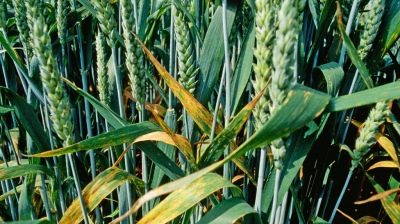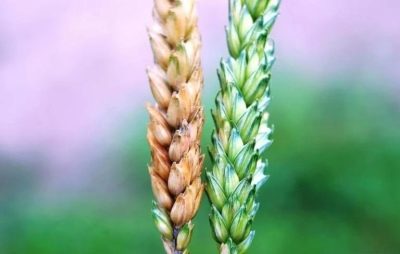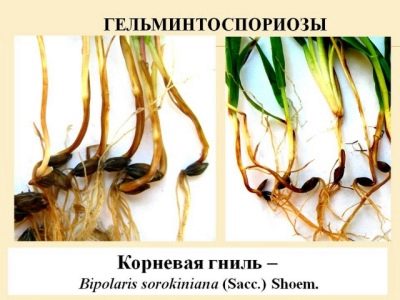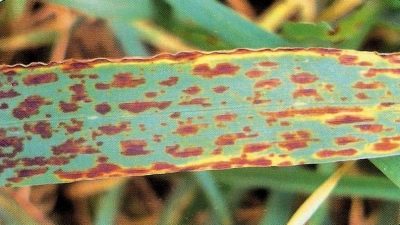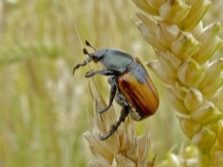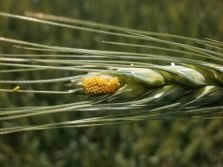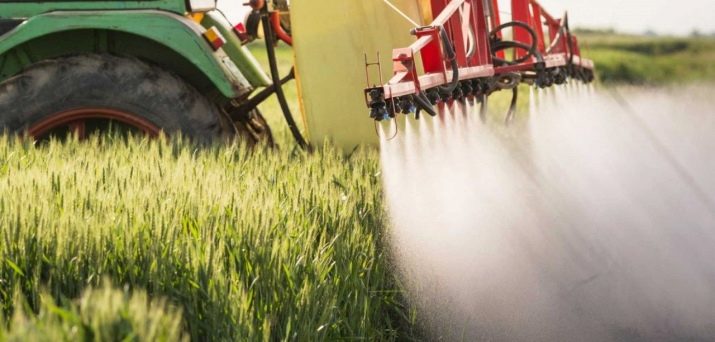Diseases and pests of wheat

In our country, wheat is one of the most common cereals grown on an industrial scale. Both agrarian enterprises and individual farmers are engaged in its production.Any threat to the harvest can lead to serious financial losses, and even be a blow to the wheat stock of the entire state. This culture is very vulnerable to various diseases and pests. It is necessary to consider in more detail the description of threats and how to deal with them.
Diseases
Fungi, bacteria and viruses for cereals pose a serious threat. Farmers have to make a lot of effort to protect the future harvest. This struggle lasts throughout the ripening season, almost to the very gathering. And in order to have something to collect, you need to carefully inspect the seedlings for possible diseases. If even the slightest signs appear anywhere, it is necessary to take action as soon as possible.
Treatment is not an easy process. It is much easier to carry out preventive treatment, because such a threat is easier to prevent than to cure.
But it is impossible to recognize the disease, if you do not know what it is. It is worth considering a few of the most common examples.
- Septoriosis - it is a fungal disease known as white spot. The second name it received for the light spots that appear on the stems and leaves. Both cultivated and wild plants are susceptible to septiciosis. The causative agent are mushrooms of various kinds. This disease is characterized by the presence of spots throughout the plant. They have a yellowish tint, dark bezel and black pycnidia. To more closely see the plaque, it is worth using a magnifying glass.
Due to septoria, wheat sprouts begin to turn yellow and dry, the grains grow small. And if the disease struck wheat in the early stages, the ears can be fruitless.
- Ear fusarium - This is another fungal disease that spreads exclusively on spikelet scales. Wheat and all other cereals grown on the territories of Russia and Europe are subject to it. Pathogens are imperfect types of fungi. Identify the disease can be on a pinkish tinge, formed on the spikelets and grain. Growing up, fungi glue the grains into dense lumps. At the same time, the infection spreading agents are located in the seeds, in the leaves and even in the soil.
- Fusarium root rot - This is a very dangerous fungal disease affecting the root system of plants. As a result of exposure to fungi, the roots may rot and begin to die. With a strong and early impact of the disease, the culture dies before the first shoots sprout. The presence of infection in germinated crops can be determined by the lower part of the stems, which will become brown. The upper part and the leaves will begin to turn white, a pinkish pattern will appear on them. Fusarium seeds are the same, while healthy ones retain their green color. Fusarium root rot is able to transform into an ear fusarium.
- Common Root Rot very similar to the Fusarium, as it also affects the root system. You can determine the lower base of the stems, which are beginning to darken. With later lesions, brown oblong spots appear on the leaves. Spikelet scales acquire the same color. When the disease grows small grains.
- Ophiobious rot occurs when there is an excess of moisture in the soil. It affects the roots and leads to the death of plants. During the period of full sprouting, the root system turns black and begins to rot, and when the earing phase begins, productive stems die. The presence of the disease can be determined by the low growth of wheat and the white color of the upper part of the stem. The lower parts at the same time turn brown, and black dots appear on the leaf sheaths. Grain is formed fine.
- Dark brown spot - This is a fungal disease of cereals, most often affecting barley and wheat. It is also known as the black germ, since the grains of diseased shoots acquire a dark color. The disease is determined by brown spikelet scales.The roots begin to rot, and the leaves are covered with oblong spots, which can be both dark and light brown.
- Pyrenophorosis - This is a disease of cereal crops, known as yellow spot. This is one of the most common diseases that affects more than 60 species of plants. Yellowish or light brown round spots appear on the leaves, while their center is lighter. In rainy weather, you can consider an inconspicuous spore bloom, which disappears when dried.
- Solid smut - This is a common disease in Russia affecting wheat. The causative agent is a species of fungi with morphological signs of teliospores. Recognize the disease can only be at the stage of milk ripeness of the grain. Sick ears are flattened, and their scales are spread apart. If you crush one spikelet, then instead of white liquid stand out from it greyish.
Pests
The second major threat to wheat is numerous pests. Among them are the following:
- aphid;
- beetles;
- fleas;
- gallate;
- sawflies;
- thrips;
- flies.
The list of subspecies is quite wide and varied. It is worth considering a few examples.
- Common Cereal Aphid - These are small insects with a round body only 3 millimeters long. They have thin legs, antennas, a tail, and two appendages, called juice tubules. In this subspecies, these tubules are almost twice as long as the tail. For warm seasons aphid can bring up to 15 generations. In winter, on the food plants you can find small larvae, from which the female hatch. She produces offspring by live birth.
This is a common subspecies in the warm regions of our country, which is not prone to migration.
- Bread bugs feed on cereals, causing serious damage to the crop. They are common in the Volga region and the Central Black Earth region of the country, have antennas on their heads, as well as wings and elytra. Their sizes differ depending on the accessory, namely:
- kuzka bread - it is the largest, reaches 16 millimeters in length, represents the greatest threat to the crop, differs in dark chestnut sheaths;
- crusader got its name for the black cruciform spot on the yellow-brown elytra, has average sizes from 10 to 13 millimeters;
- beautiful - This is the smallest subspecies, whose maximum length does not exceed 12 millimeters; it is distinguished by yellowish sheaths without spots, but with light hairs.
Important! Not only adult beetles, but also larvae can inflict crop damage. The first ones are operating on crops in spring, the second ones start raids in early summer. The main activity occurs in the daytime.
- Bread flea - These are small bugs with an oval body shape. They move with the help of big jumps, they attack crops in early spring. They are divided into two types.
- Leafy also known as striped. Their sizes do not exceed two millimeters. They differ in prevalence in all regions of Russia and far beyond its borders. This subspecies feeds on the leaves, gnawing at them numerous holes, because of which the plants begin to wither and die.
- Stem can be as ordinary (from one and a half to two millimeters in length) and large (up to three millimeters in length). They are also common throughout the country, but are most active in the Volga region and the Central Black Earth region. Larvae cause the greatest damage when shoots appear. They gnaw their way through the stems. Shoots begin to turn yellow and fade.
Control measures
As mentioned above, the threat is easier to prevent than to get rid of it. Before sowing, the following preventive measures are recommended:
- after harvesting, re-plowing should be carried out in order to destroy pathogens and pests that love to hibernate in the soil, which will reduce the risk of infection of the next crop;
- optimal sowing time must be observed, for example, many diseases develop better on winter wheat, from which other cultures successfully migrate; the main thing is to deprive the pathogens of favorable conditions for the spread of infection;
- if there is a chance that a certain area is infected, you should not plant crops next to it;
- before planting, seed should be treated with special substances that will either save seedlings from diseases or heal infected seeds;
- Do not forget to carry out chemical treatment of crops.
but regular prevention does not guarantee complete protection against various threats. It should always be on the alert. Of course, in most cases, fungicide treatment saves from diseases and insects. But it is better to find out the specific symptoms in order to understand exactly what measures to take against the disease.
For more information about the diseases of cereals see the following video

